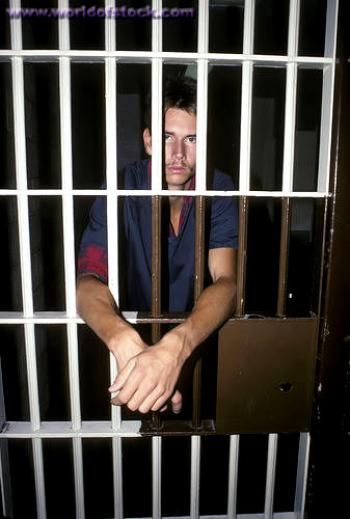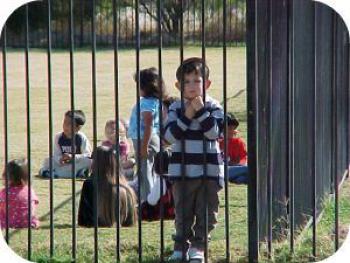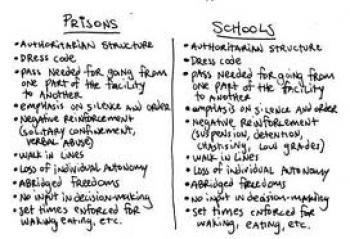Serendip is an independent site partnering with faculty at multiple colleges and universities around the world. Happy exploring!
Voice Paper #2



“The uniforms are just like the ones we had to wear in elementary school. Same white shirts and blue pants. When I look at these, I can’t help but thinking, what were they preparing us for?”- quote from a student from Percy Julian High School from Meiners’ book “Right to Be Hostile”
As HSBurke’s post and the Meiner’s quote display, there are many similarities between schools and prisons. It is important to note that these similarities do not occur between all schools and prisons, but more commonly between urban, underfunded schools and prisons. When I hear about these similarities I react very strongly: How could this be, why are students being treated like prisoners? Don’t all children deserve an equal chance in life? Although I may feel very strongly about this, I sometimes feel unable to express my opinions or the reasoning behind why I feel the way I do. My biggest issue with allowing schools and prisons to be so similar is the expectation it sets up for students. School is supposed to prepare students for their futures, and if schools and prisons function similarly, it seems safe to say schools are preparing students to successfully take on the role of prisoners. Beyond that though, I struggle to articulate why this issue makes me react so viscerally.
One of the best methods to understand your own opinion is to try to understand the opposite perspective. Therefore, I would like to use the believing/doubting method to explore the similarities between schools and prisons and try to express why I think it is wrong for students to be treated like prisoners. Although prisoners also don’t deserve the treatment they receive, because this is a short paper, I will specifically focus on doubting and believing the impact of some of the similarities (listed in the image above) on students in school, rather than how these similarities impact both students and prisoners.
Before I begin believing/doubting, it is important to realize what this image of the list of similarities is trying to convey. It seems apparent that whoever created this list is unhappy with these similarities between schools and prisons. Because they believe the similarities are negative, the language also tends to be very negative and the specific language that is used can really alter the way we feel about something. For example, it would be very unexpected for someone to say they are pro-abortion (as opposed to pro-choice) or for someone to say they are anti-choice (as opposed to pro-life). In my believing/doubting process, I think it is also important to reframe or reword some of the similarities listed so that I am able to better understand both sides of the argument.
Authoritarian Structure:
Believing: Authoritarian structure can be useful in schools, because as children and minors, students need guidance and leadership to foster their learning. As mentioned above, the phrase “authoritarian structure” may create negative connotations for people. If schools were said to have a “structured environment” as opposed to “authoritarian structure” I think that would be better received. Having a structured environment is often very healthy for students: it creates a sense of normalcy, sets up guidelines and expectations for success, and prepares them for many future jobs that will also have a specific structure. There are many structures put in place by administrators and teachers that ultimately benefit the student, such as homework and curriculum. Having a structured environment will also designate roles and allows students to understand their place of belonging within the school community.
Doubting: Although authoritarian structure designates roles, the role of “student” may not be a desired role because it is at the bottom on the pyramid in the hierarchy of schools. This is detrimental to the students’ sense of self because it takes away their voice and makes them feel unequal. Yes, the teachers have the degrees and years of experience, but that does not make the students unimportant. There should be “democratic communication which disconfirms domination” (Freire & Shor, pg 99) in the classroom if we want students to learn to think critically and be able to go beyond following a simple, mind numbing routine. Students participation in aspects of schooling, such as curriculum, is essential because they are the people being impacted by it; if students are editing, expanding, and clarifying the curriculum, they are not only impacting their own learning, they are changing their role in the school from docile learner to active participant and helping future students.
Dress Code:
Believing: When students have a dress code, this eliminates a lot of visual difference among students, which could alleviate some socioeconomic tension in the schools and also alleviate a source of bullying. When students are following a dress code it allows them to focus on what is important in school: they’re academic work. It may be fun to chat about the latest styles or fashions, but at school this should not be a student’s priority. They are there to learn, not impress others with their clothing.
Doubting: Dress codes cannot be enforced in public school because it is taking away a student’s basic right to dress how they desire. Some would argue that wearing a uniform prepares students for the real world. This may be true, if your expectation is that your students will be working lower level jobs, like at grocery stores, or if you expect your students to be prisoners. However, if you expect your students to become CEOs, they will be deciding what to wear to work every day. Also, logistically speaking, where will the money for uniforms come from? Will students pay? Will the schools pay? If the schools are paying, might that money be used for something more necessary, such as updated history books or a computer lab?
Abridged freedoms:
Believing: I’m not sure what freedoms this is referring to, but for the sake of simplicity, I am going to talk about metal detectors in school. The benefits of having metal detectors in school seem pretty clear: when metal detectors are put in school, the intent is to keep students safe. If you don’t have weapons, it shouldn’t really be an issue walk through a metal detector before school.
Doubting: Metal detectors create an environment of distrust and don’t solve problems of violence. Metal detectors can be faulty, both going off when they shouldn’t and not going off when they should. There are understandable items that students may have, like scissors, which set off the detector. Putting metal detectors in schools does not end violence: fist fights can still occur, or students will get in fights outside of school. A better way to address violence and weapons would be to discuss with the students why violence occurs and why people carry weapons. Putting a metal detector in the schools seems to silence conversations about these important subjects because they are seen as solutions to the problem.
In the process of examining my reactions to why the similarities between schools in prisons bother me, I began to think about reframing the language of the similarities, and also reframing my question original question. Instead of asking “Why are students being treated like prisoners?” and comparing student and prisoner treatment, I began to question why are students treated the way they are in general. Given that, what if students were treated in ways that I deemed “good” (ie: in ways that were conducive to learning, fostered a safe environment, and allows for students to receive personal attention, not surveillance)? Is the problem that students are being treated like prisoners, or that students are receiving inadequate education? If students were receiving exemplary education, would I want prisoners to be treated like students? These are questions that I cannot answer, but hope to keep exploring throughout the semester.


